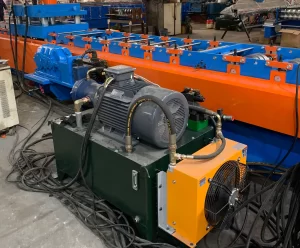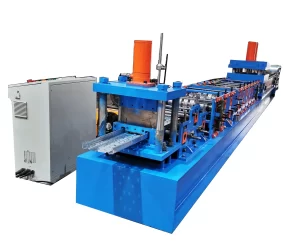The Core of Industrial Production
In the fine system of modern industrial making, the Nožný pedálový tvárniaci stroj works as a quiet but able “industrial base,” pushing productivity rises in many fields with the exactness of machine help. When scaffolding grows like a steel wood at building places, its main part—the scaffolding board—is always made by this tool at a rate of 12 meters each minute. In car-making lines, the right curves of the inside supports and foot pedals come from the many rolls of its roller tools. This tool, joining jobs of “cut-form-punch,” is changing the way goods are made in old times with its “Swiss Army Knife”-like usefulness, and is important between raw items and finished industrial goods.

How Structure Merges with Function
The Art of Engineering in Mechanical Design
- The equipment main body is welded from Q345B high-strength carbon steel; the body thickness is 20mm, capable of withstanding a rolling pressure of over 30 tons. The frame structure adopts mechanical balance design; columns and beams are reinforced by triangular supports to ensure that the amplitude during high-speed operation is ≤0.08mm. The operation panel adopts ergonomic layout; emergency stop buttons, parameter adjustment knobs, and LED working condition display are put in a fan shape making it possible for operators to complete the entire process within a 0.5-meter range.
- The magnetic powder brake can carry coils having a diameter of 1.2 meters and a weight of 5 tons. It adjusts the uncoiling speed in real time through a tension sensor to avoid wrinkles in metal sheets caused by sudden changes in tension
Seven rollers adopt an upper-three-lower-four layout. GCr15 bearing steel, rollers quenching with a hardness value of HRC60-62, capable of precision leveling steel plates of 0.5-4mm thickness; flatness within 0.2mm/m control; - The CNC punching unit has 20 20-ton hydraulic punch presses, with a punching speed of 30 times per minute and hole position accuracy of ±0.3mm. It supports switching more than 20 hole types, which are round holes, long holes, and waist-shaped holes.
Core Functions Analysis: Technology-Driven Efficiency Upgrades
- Accurate Control of the Servo Feeding System
It uses a Panasonic MINAS A6 servo motor with a 2000-line encoder, achieving feeding accuracy of ±0.05mm. When a material thickness fluctuation greater than 0.1mm is detected, it feeds back through the pressure sensor and automatically adjusts the feeding speed (0-25m/min adjustable). Example: Production of 2mm galvanized sheets; the error of traditional mechanical feeding is about ±1mm. The servo system controls the error within ±0.3mm, laying a foundation for subsequent roll forming. - The Mystery Behind the Continuous Roll Forming Process
The forming unit has 12 sets of dies, the first 6 sets are rough forming rolls last 6 sets are fine forming rolls. Take the U-shaped groove processing of scaffolding planks as an example: 1st-3rd sets of rollers complete 90° pre-bending with 5° compensation reserved; 4th-6th sets of rollers perform arc correction to control groove depth error within ±0.5mm; 7th-12th sets of rollers finish surface to make roughness Ra≤1.6μm. The entire process is controlled by a PLC program that can store forming parameters of fifty different products and switching time ≤10 minutes. - The Breakthrough of Intelligent Cutting Technology
A breakthrough in intelligent cutting technology: adopting a hydraulically driven flying shear device, the cutting speed reaches 80 times per minute, capable of burr-free cutting of steel plates below 4mm. The system supports two modes: fixed-length cutting (0.5-6m) and meter-counting cutting. With photoelectric sensor positioning, the length error is ≤±1mm; efficiency increases by 8 times compared to traditional manual marking and cutting.

Three core advantages, redefining industrial production standards
- Double Increase in Production Capacity and Efficiency
The daily production capacity of one single production line reaches 12,000 meters (calculated as 2m long scaffolding planks, 6,000 pieces per day), equivalent to the daily workload of 20 skilled workers. After a construction equipment factory introduced this equipment, the delivery cycle for scaffolding planks was shortened from 7 days to 2 days; the order response speed increased by 71%. - Quality Assurance of Precise Manufacturing
The quality inspection process ISO9001 certified proves to all that the equipment has produced scaffolding planks with tensile strength 345MPa and yield strength 235MPa, both exceeding requirements by GB/T 1591-2018. Results from salt spray testing (5% NaCl solution, 240 hours) prove that the corrosion rate of the galvanized layer is ≤0.1mm/year, suitable for coastal construction projects. - Flexible Customization Capability
Supporting rapid die replacement (die change time ≤30 minutes), it can produce more than 20 types of profiles such as C-shaped steel (100-300mm), Z-shaped steel (120-250mm), and U-shaped grooves (50-200mm). An automobile parts factory used this equipment to customize aluminum alloy battery pack brackets for new energy vehicle models, achieving a 90° bending + flanging process through 16 sets of special dies, with a product yield rate of 99.2%.
Accurate Response from Requirement to Implementation
- Conversion of Requirements into Engineering
The technical team converts customer requirements into parameters of process control with the aid of SolidWorks 3D modeling. For instance, a photovoltaic enterprise required the bending angle of the support profile to be 158°±1°. The technical personnel calculated the die compensation angle to be 162° through FEA simulation of the rolling process. The final product angle error was ≤0.5°. - Reverse Design of Dies
For special-shaped parts, sample data is obtained using 3D scanning technology (accuracy ±0.02mm), and reverse die design is carried out through UG software. An aerospace enterprise’s foot pedals from titanium alloy. To solve the problem of thermal deformation in the processing of titanium alloy, the technical team designed special dies with cooling grooves based on the scanning data. - Full-Process Quality Control System
Trial production is implementing the “three-inspection system” (first inspection, patrol inspection, and final inspection) by coordinate measuring machine (accuracy ±0.01mm), key dimensions detectable. In this high-speed rail parts project, 200 trial production adjustments finally achieved the straightness of the profile at 0.1mm/m- CRCC certification requirement.

Different Application Scenes: Technical Adaptation Across Industries
The Safety Base of Construction Projects
During the third runway construction of Hong Kong International Airport, the scaffolding planks from this equipment supported a 120-meter high-altitude work platform. The anti-slip groove depth reached 0.8mm; the friction coefficient was 0.65, safe for construction personnel during typhoon seasons. The planks are bolt-connected by exact punching; joint bearing capacity is up to 2.5 tons, more than the requirements of British Standard BS 1139.
- The Accurate Ally of Top-Tier ProductionAerospace: Making the cockpit foot controller brackets for the C919 plane, using 7075-T6 aluminum alloy material, achieving a 0.3mm wall thickness shape through 10 sets of exact dies, with no inner hole flaws found by X-ray flaw check;
- Medical Devices: Making shield cabin door frames for CT tools, using a stainless steel roll forming technique to make the weld tightness reach 1×10⁹Pa ·m³/s, meeting radiation safety rules.
- Rail Transit: Process the roof AC brackets for subway cars, via synchronized control of servo feed & roll, making the bracket’s vibration frequency dodge the vehicle resonance range(18- 22Hz).
In the hydrogen energy field, this equipment is capable of processing metal bipolar plates for fuel cell stacks. It achieves this through roll forming 0.1mm ultra-thin stainless steel plates, attaining flow channel size accuracy of ±0.03mm but also ensuring uniform distribution of hydrogen and oxygen.
From building scaffolds to high-precision parts for planes, the Foot Pedal Roll Forming Machine has come to be a main way of improving industry with its two great benefits of “precise making + easy producing.” In the wave of smart making, it will keep giving full solutions from “raw material” to “final product” for many fields through tech changes in smartness, eco-friendliness, and mixing, truly becoming an irreplaceable “jack-of-all-trades” in modern industrial output.




